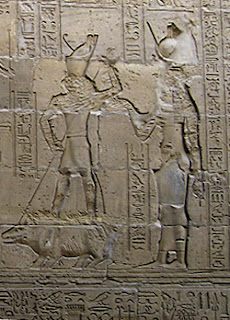GEB
GEB god of the earth
Geb was the Egyptian god of the Earth and a member of the Ennead of Heliopolis. It was believed in ancient Egypt that Geb's laughter were earthquakes and that he allowed crops to grow.Name
The name was pronounced as such from the Greek period onward and was formerly erroneously read as Seb[1] or as Keb. The original Egyptian was "Gebeb"/"Kebeb", meaning probably: 'weak one', perhaps 'lame one'. It was spelled with either initial -g- (all periods), or with -k-point (gj). The latter initial root consonant occurs once in the Middle Kingdom Coffin Texts, more often in 21st Dynasty mythological papyri as well as in a text from the Ptolemaic tomb of Petosiris at Tuna el-Gebel or was written with initial hard -k-, as e.g. in a 30th Dynasty papyrus text in the Brooklyn Museum dealing with descriptions of and remedies against snakes.
Role and development
The oldest representation in a fragmentary relief of the god, was as an anthropomorphic bearded being accompanied by his name, and dating from king Djoser's reign, 3rd Dynasty, and was found in Heliopolis. In later times he could also be depicted as a ram, a bull or a crocodile (the latter in a vignet of the Book of the Dead - papyrus of the lady Heryweben in theEgyptian Museum, Cairo).
Frequently described mythologically as father of snakes (one of the names for snake was s3-t3 - 'son of the earth' and in a Coffin Texts-spell Geb was described as father of the snake Nehebkau, while his mother was in that case Neith) and therefore depicted sometimes as such. In mythology Geb also often occurs as a primeval divine king of Egypt from whom his sonOsiris and his grandson Horus inherited the land after many contendings with the disruptive god Set, brother and killer of Osiris. Geb could also be regarded as personified fertile earth and barren desert, the latter containing the dead or setting them free from their tombs, metaphorically described as 'Geb opening his jaws', or imprisoning those there not worthy to go to the fertile North-Eastern heavenly Field of Reeds. In the latter case, one of his otherworldly attributes was an ominous jackal-headed stave (called wsr.t) rising from the ground unto which enemies could be bound.
In the Heliopolitan Ennead (a group of nine gods created in the beginning by the one god Atum or Ra), Geb is the husband of Nut, the sky or visible daytime and nightly firmament, the son of the earlier primordial elements Tefnut (moisture) and Shu ('emptiness'), and the father to the four lesser gods of the system - Osiris, Seth, Isis and Nephthys. In this context, Geb was believed to have originally been engaged in eternal sex with Nut, and had to be separated from her by Shu, god of the air.[2] Consequently, in mythological depictions, Geb was shown as a man reclining, sometimes with his phallus still pointed towards Nut.
As time progressed, the deity became more associated with the habitable land of Egypt and also as one of its early rulers. As a chthonic deity he (like Min) became naturally associated with the underworld and with vegetation -barley being said to grow upon his ribs- and was depicted with plants and other green patches on his body.
His association with vegetation, and sometimes with the underworld and royalty brought Geb the occasional interpretation that he was the husband of Renenutet, a minor goddess of the harvest and also mythological caretaker (the meaning of her name is 'nursing snake') of the young king in the shape of a cobra, who herself could also be regarded as the mother ofNehebkau, a primeval snake god associated with the underworld. He is also equated by classical authors as the Greek Titan Cronus.
Resources:
- wikipedia
- Google Image Search








.jpg)






















































